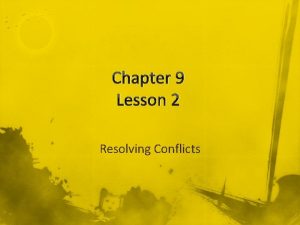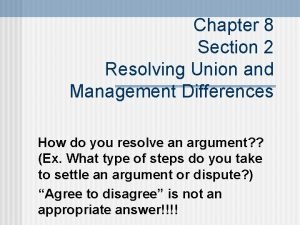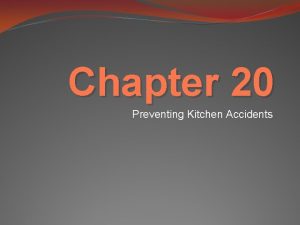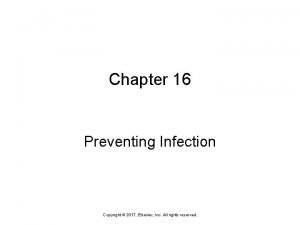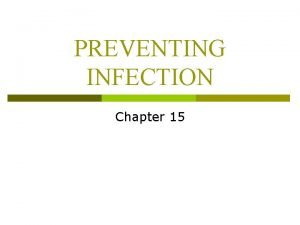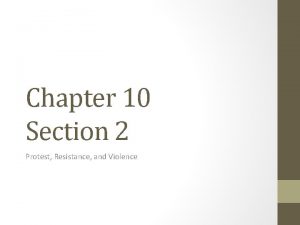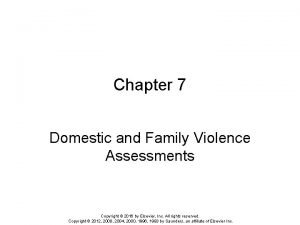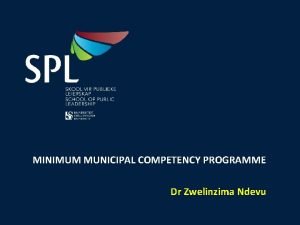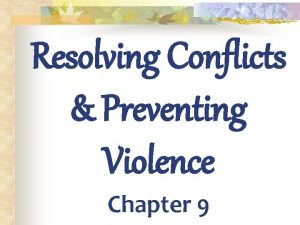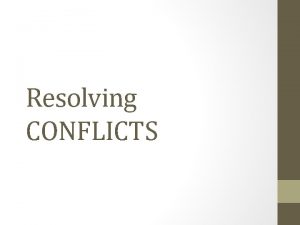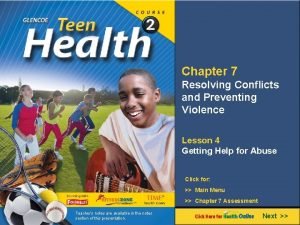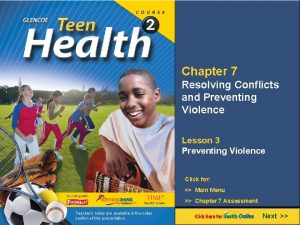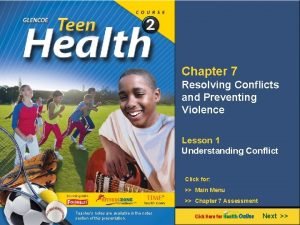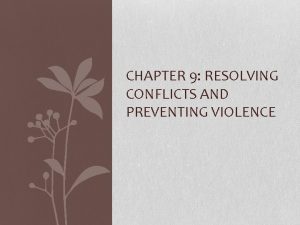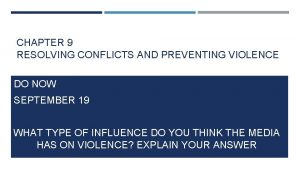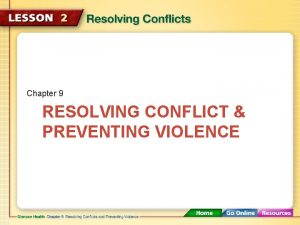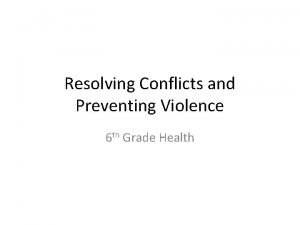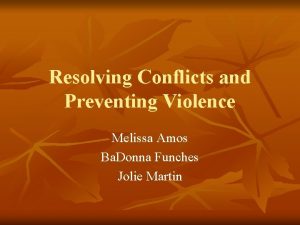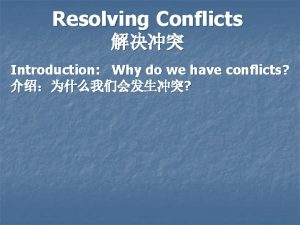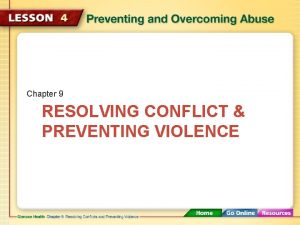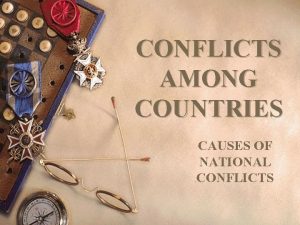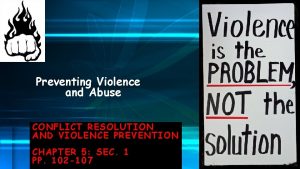CHAPTER 9 RESOLVING CONFLICTS AND PREVENTING VIOLENCE UNIT





















- Slides: 21

CHAPTER 9: RESOLVING CONFLICTS AND PREVENTING VIOLENCE UNIT 3: HEALTHY AND SAFE RELATIONSHIPS

OBJECTIVES Maintain knowledge of why conflicts occur and how to prevent them Understand conflicts can be resolved through negotiation or mediation List forms of violence and ways to protect yourself Prevent abuse and learn ways to overcome abuse

CAUSES OF CONFLICT LESSON 1

UNDERSTANDING CONFLICT Conflict: any disagreement, struggle, or fight Interpersonal conflict: conflicts between people or groups of people Usually occur when one party's needs, wishes, or beliefs clash with the other party Internal conflicts: conflicts that take place within an individual

CAUSES OF CONFLICT Power struggles Personal loyalties Jealousy and envy Property disputes Conflicting attitudes and values Lack of respect

CONSEQUENCES OF CONFLICT Conflict is a normal part of life Conflict can bring about positive/negative results Working on solving an issue can bring about better communication (positive) Getting an individual to view something in a different way (positive) Strengthen relationships (positive) Adding stress (negative) Harm social and physical health (negative) Cause a person to lose their job (negative) How can we prevent conflict?

RESOLVING CONFLICTS LESSON 2

RESOLVING CONFLICTS Minor conflicts can often be resolved with compromising What do you do if you and your sibling disagree about what to watch on TV? Negotiation: the use of communication and compromise to settle a disagreement This involves finding an agreement that both sides can accept

1 2 3 4 5 6 7 1. Take time to calm down and think over the situation 2. Let each party take turns explaining its side of the conflict without interruption 3. Ask for clarification to make sure that each party understand the other's position 4. Brainstorm solutions to the conflict 5. Discuss advantages and disadvanta ges of each solution 6. Agree on a solution that is acceptable to both sides 7. Follow up to see whether the solution worked for each side THE NEGOTIATION PROCESS

THE MEDIATION PROCESS Mediation: bringing in a neutral third party to help others resolve their conflicts peacefully Effective mediation: Neutrality: mediator must be an outsider who has no stake in the dispute Confidentiality: respecting the privacy of both parties and keeping detail a secret Well-defined ground rules

PEER MEDIATION Peer mediation: process in which specially trained students help each other resolve conflicts peacefully Peer mediation involves: Making introductions Establishing ground rules Hearing each side Exploring solutions Wrapping it up

UNDERSTANDING VIOLENCE LESSON 3

CAUSES OF VIOLENCE Violence: the threatened or actual use of physical force or power to harm another person or to damage property Causes of violence include: Alcohol and drug use Mental and emotional problems Availability of weapons Violence in the media Gang violence

TYPES OF VIOLENCE Violence can be physical or sexual Nearly half of the victims of violent crimes knew their attacker Assault: an unlawful physical attack or threat of attack Random violence: violence committed for no particular reason Homicide: the willful killing of one human being by another

SEXUAL VIOLENCE Sexual violence: any form of unwelcome sexual contact directed at an individual Sexual assault: any intentional sexual attack against another person In 2012, 73, 000 sexual assaults were reported in the US Rape: any form of sexual intercourse that takes place against a person's will. How do you protect yourself? Be aware of your surroundings Refuse to go anywhere alone—especially if you don't know the other person Attend gatherings with friends Avoid alcohol and drugs Trust your instincts

HATE CRIMES Hate crime: crime motivated by hatred or prejudice against a particular group Hate crimes can be in the following forms: Harassment Vandalism Arson Assault and Homicide

PREVENTING AND OVERCOMING ABUSE LESSON 4

FORMS OF ABUSE Physical abuse: a pattern of intentionally causing bodily harm or injury to another person Emotional abuse: pattern of attacking another person's emotional development an sense of worth Verbal abuse: the use of words to mistreat or injure another person Sexual abuse: pattern of sexual contact that is forced upon a person against the person's will Stalking: repeatedly following, harassing, or threatening an individual

DATE RAPE AND ACQUAINTANCE RAPE Date rape: one person in a dating relationship forces the other person to take part in sexual intercourse More than 40% of female rape victims and more than 10% of male rape victims are romantically involved with their attackers Acquaintance rape: attacker is someone the victim knows casually or considers a friend Affects male victims most often Alcohol plays a major role in date rape Rohypnol ("Roofies"), GHB, and ketamine

OVERCOMING ABUSE Counseling can help survivors of abuse recover from its effects People who have survived rape or abuse may have a variety of emotions Survivors can seek support from the following: Parents, guardians, other trust adults Teachers, coaches, school nurses, or guidance counselors Members of the clergy Police Private physicians or ER Shelters for victims Rape crisis center Therapists, counselors, or support groups

REFERENCE Bronson, Mary H. Florida Health. Mc. Graw-Hill, 2015.
 Chapter 9 resolving conflicts and preventing violence
Chapter 9 resolving conflicts and preventing violence Chapter 9 resolving conflicts and preventing violence
Chapter 9 resolving conflicts and preventing violence Chapter 9 lesson 2 resolving conflicts
Chapter 9 lesson 2 resolving conflicts Modified union shop definition
Modified union shop definition Chapter 24 lesson 2 preventing and treating stds
Chapter 24 lesson 2 preventing and treating stds Chapter 14:2 preventing accidents and injuries
Chapter 14:2 preventing accidents and injuries Chapter 13:2 preventing accidents and injuries
Chapter 13:2 preventing accidents and injuries Chapter 20 preventing kitchen accidents
Chapter 20 preventing kitchen accidents Chapter 16 preventing infection
Chapter 16 preventing infection Chapter 4 preventing injuries through fitness
Chapter 4 preventing injuries through fitness Chapter 15 preventing infection
Chapter 15 preventing infection Dispersive power of a grating is:
Dispersive power of a grating is: Recognizing and resolving abo discrepancies
Recognizing and resolving abo discrepancies Chapter 27 anger aggression and violence
Chapter 27 anger aggression and violence Chapter 10 section 2 protest resistance and violence
Chapter 10 section 2 protest resistance and violence Rising tide chapter
Rising tide chapter Routine, universal screening for domestic violence means: *
Routine, universal screening for domestic violence means: * Seceding states of the confederacy
Seceding states of the confederacy Thin film formula
Thin film formula Telescope equations
Telescope equations Resolving power of human eye in mm
Resolving power of human eye in mm 5 steps in resolving ethical dilemmas
5 steps in resolving ethical dilemmas


